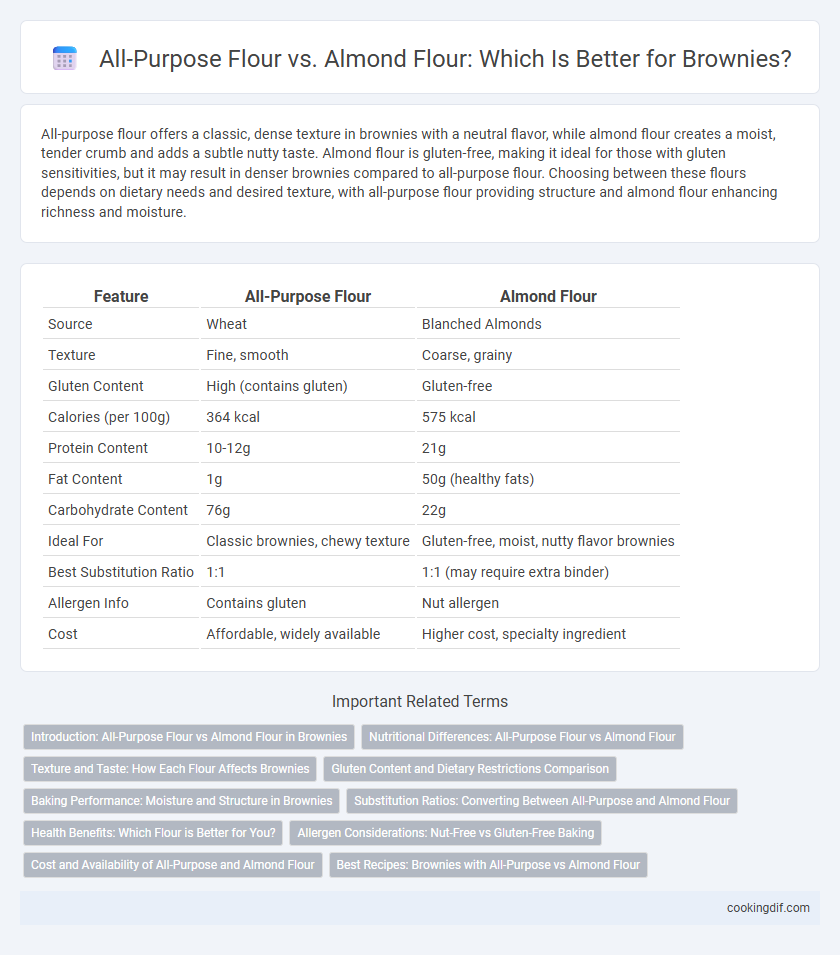All-purpose flour offers a classic, dense texture in brownies with a neutral flavor, while almond flour creates a moist, tender crumb and adds a subtle nutty taste. Almond flour is gluten-free, making it ideal for those with gluten sensitivities, but it may result in denser brownies compared to all-purpose flour. Choosing between these flours depends on dietary needs and desired texture, with all-purpose flour providing structure and almond flour enhancing richness and moisture.
Table of Comparison
| Feature | All-Purpose Flour | Almond Flour |
|---|---|---|
| Source | Wheat | Blanched Almonds |
| Texture | Fine, smooth | Coarse, grainy |
| Gluten Content | High (contains gluten) | Gluten-free |
| Calories (per 100g) | 364 kcal | 575 kcal |
| Protein Content | 10-12g | 21g |
| Fat Content | 1g | 50g (healthy fats) |
| Carbohydrate Content | 76g | 22g |
| Ideal For | Classic brownies, chewy texture | Gluten-free, moist, nutty flavor brownies |
| Best Substitution Ratio | 1:1 | 1:1 (may require extra binder) |
| Allergen Info | Contains gluten | Nut allergen |
| Cost | Affordable, widely available | Higher cost, specialty ingredient |
Introduction: All-Purpose Flour vs Almond Flour in Brownies
All-purpose flour offers a classic, chewy texture and rich cocoa flavor in brownies, providing reliable structure due to its gluten content. Almond flour creates a moist, dense brownie with a subtle nutty taste, ideal for gluten-free or low-carb diets, while contributing healthy fats and protein. Choosing between all-purpose and almond flour depends on desired texture, dietary needs, and flavor preferences in brownie recipes.
Nutritional Differences: All-Purpose Flour vs Almond Flour
All-purpose flour contains higher carbohydrates and lower fat compared to almond flour, making it less suitable for low-carb diets. Almond flour offers more protein, fiber, and healthy fats, along with essential nutrients like vitamin E and magnesium. These nutritional differences affect the texture and calorie content of brownies, with almond flour resulting in a denser, moister treat.
Texture and Taste: How Each Flour Affects Brownies
All-purpose flour yields brownies with a classic dense and chewy texture, providing a neutral taste that highlights the cocoa's richness. Almond flour produces a moist, tender crumb with a slightly nutty flavor, enhancing the brownies' overall complexity and adding a subtle sweetness. Texture-wise, almond flour brownies tend to be softer and more delicate, while all-purpose flour creates a firmer, more structured bite.
Gluten Content and Dietary Restrictions Comparison
All-purpose flour contains gluten, which provides structure and chewiness essential for traditional brownie texture, while almond flour is gluten-free, making it suitable for individuals with celiac disease or gluten sensitivity. Almond flour contributes a denser, moister crumb with a slightly nutty flavor, beneficial for low-carb and paleo diets, but may alter the classic fudgy consistency of brownies. Selecting between these flours depends on dietary restrictions and texture preference, balancing gluten content's impact against the nutritional benefits and allergy considerations of almond flour.
Baking Performance: Moisture and Structure in Brownies
All-purpose flour provides a balanced protein content that creates a sturdy yet tender structure in brownies, ensuring optimal moisture retention and a classic chewy texture. Almond flour, with its higher fat content and lack of gluten, yields denser, moister brownies with a rich, buttery flavor but a more fragile crumb. Choosing between these flours impacts the final brownie's texture, moisture levels, and overall structural integrity.
Substitution Ratios: Converting Between All-Purpose and Almond Flour
When substituting almond flour for all-purpose flour in brownies, use a ratio of approximately 1:1, but reduce the quantity slightly since almond flour is denser and contains more moisture. For every cup of all-purpose flour, use about 3/4 cup of almond flour to maintain proper texture and consistency. Adjust baking time and leavening agents as almond flour affects rise and browning differently than all-purpose flour.
Health Benefits: Which Flour is Better for You?
Almond flour offers higher protein, fiber, and healthy fats compared to all-purpose flour, supporting better blood sugar control and heart health. All-purpose flour is lower in calories but lacks essential nutrients and can cause blood sugar spikes due to its high glycemic index. Choosing almond flour enhances the nutritional profile of brownies, making it a better option for those seeking health benefits and gluten-free alternatives.
Allergen Considerations: Nut-Free vs Gluten-Free Baking
All-purpose flour is a nut-free option ideal for those with nut allergies, ensuring safe consumption in baked goods like brownies. Almond flour caters to gluten-free diets but poses significant risks for individuals with nut sensitivities or allergies. Selecting the appropriate flour depends on prioritizing allergen considerations, balancing nut-free safety with gluten-free dietary needs.
Cost and Availability of All-Purpose and Almond Flour
All-purpose flour is widely available in grocery stores at a lower cost, making it a budget-friendly choice for brownie recipes. Almond flour, typically more expensive and less accessible in some regions, is often found in specialty or health food stores. Cost and availability considerations make all-purpose flour the preferred option for most bakers seeking convenience and affordability in brownies.
Best Recipes: Brownies with All-Purpose vs Almond Flour
All-purpose flour produces brownies with a classic dense, fudgy texture and rich cocoa flavor, ideal for traditional recipes that require structure and chewiness. Almond flour creates moist, tender brownies with a slightly nutty taste and gluten-free benefits, perfect for those seeking grain-free or paleo-friendly options. Recipe adjustments such as increased eggs or binding agents are necessary when using almond flour to achieve optimal rise and texture.
All-Purpose Flour vs Almond Flour for flour choice Infographic

 cookingdif.com
cookingdif.com